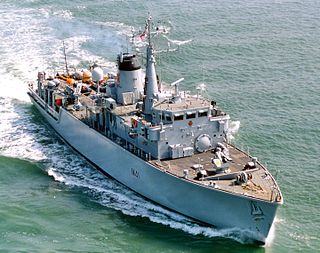Related Research Articles
Three ships of the Royal Navy have been named HMS Quorn, all named after the Quorn Hunt.

The Hunt class is a class of thirteen mine countermeasure vessels of the Royal Navy. As built, they combined the separate roles of the traditional minesweeper and that of the active minehunter in one hull, but later modifications saw the removal of mine-sweeping equipment. They have a secondary role as offshore patrol vessels.
Three ships of the Royal Navy have been named HMS Atherstone after the town of Atherstone in Warwickshire, or after its hunt:
Three ships of the Royal Navy have been named HMS Brocklesby after the Brocklesby hunt:
Three ships of the Royal Navy have been named HMS Cattistock after the Cattistock hunt:
Three ships of the Royal Navy have been named HMS Cottesmore after the Cottesmore hunt:
Two ships of the Royal Navy have been named HMS Middleton after the Middleton hunt:
Two ships of the Royal Navy have been named HMS Dulverton after the Dulverton hunt:
Two ships of the Royal Navy have been named HMS Ledbury, named after Ledbury Hunt, Herefordshire:

HMS Bicester was a Hunt-class mine countermeasures vessel of the Royal Navy. She was sold to the Greek Navy in 2001 as Europa.
Two ships of the Royal Navy have borne the name HMS Taurus, after the Greek for bull.
Two ships of the Royal Navy have borne the name HMS Chiddingfold after the fox hunt at Petworth, Sussex:
Three ships of the British Royal Navy have been named HMS Oakley:

HMS Bicester(pennant number L34) was an escort destroyer of the Type II Hunt class. The Royal Navy ordered Bicester's construction three months after the outbreak of the Second World War. Hawthorn Leslie & Co. laid down her keel at their Tyne yard on 29 May 1940, as Admiralty Job Number J4210. The ship was named after a fox hunt in Oxfordshire.
Two ships of the Royal Navy have been named HMS Blackmore, named after Blackmore, Essex:

HMS Zetland was a Royal Navy Type II Hunt-class destroyer, named after the Zetland Hunt.
Belvoir has been the name of two Royal Navy warships:

HMS Derwent was a Hunt-class Type III destroyer escort of the Royal Navy. She was built by Vickers-Armstrongs, in Barrow-in-Furness, and served during the Second World War. In March 1943, she was badly damaged while anchored in Tripoli harbour by aircraft and beached to prevent her from sinking. Temporarily repaired and towed to England, further repair work was halted in January 1945, and she was broken up for scrap in 1947.
Two ships of the Royal Navy have been named HMS Holderness. They were "Hunt-class" ships of different periods, named after the Holderness Hunt which operates in the Holderness area of Yorkshire.
References
- ↑ "H.M.S. Bicester (1917)". The Dreadnought Project.